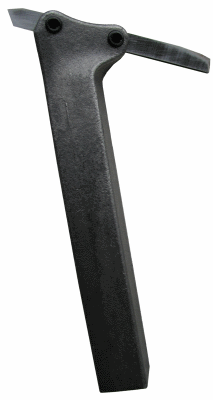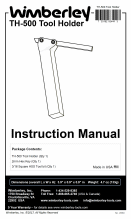The Wimberley Toolholder - Advantages

The inexpensive high speed steel tool bit is easy to sharpen. The toolholder's built-in back and side rake allow for efficient cutting in a variety of materials including steel and aluminum. Facing and turning can be accomplished with the holder in one orientation. This ensures that a very sharp edge is always just a few minutes and cents away.
Free samples are available to those in positions of high visibility such as authors published in The Home Shop Machinist or similar magazines.

Advantages of Using The Wimberley Toolholder
Ease of Use/Convenience

- The toolholder uses inexpensive square high speed steel tool bits.
- The bit is easy to sharpen (see Sharpening section).
- Turning and facing with the same bit can be accomplished with the toolholder shank in the conventional position.
- The toolholder works perfectly with quick-change tool posts such as the Aloris system, the shank of the tool being oriented 90 degrees to the axis of lathe just like most standard lathe tools.
- Both turning and facing with the same bit can be accomplished with the toolholder shank in the conventional position.
- The tool bit projects to the left of the toolholder and tool block, making the tool bit tip easy to see, and making it easy to avoid accidentally running part of the lathe into the chuck.
- The toolholder is inexpensive so that the user can buy two if desired, allowing instant access to two tool bit geometries at all times.
Sharpening

- The unique geometry of the toolholder orients the bit so that one of the long factory-finished sides of the tool bit, serving as the rake face, is inclined so as to produce equal side and back rake angles.
- No special grinding fixture is used; an Aloris tool block or the like holds the toolholder which, in turn, holds the bit.
- The grinder table is set only once, to establish relief angle.
- Sharpening involves grinding the flanks of the tool where the wear occurs, thus ensuring efficient use of the tool bit.
- Positive and negative lead angle tool bits, each of which can both turn and face, can be produced that create a chamfer or an inside corner.
- Sharpening a bit in a Wimberley toolholder is good practice for learning conventional high speed steel tool bit grinding.
Operating Characteristics

- The built in rake angles are appropriate for most steel, aluminum, plastic and wood, but not for material that call for zero rake angles such as some brasses.
- The relatively high rake angles provide efficient and cool cutting, and noticeably reduce the load on the lathe.
- The very sharp edges that are easily obtainable make it easy to get consistent uniform finishes and accurate diameters.
- The generous back rake makes facing surprisingly easy and helps create smooth and uniform turning cuts.
- Harder materials simply require lower machining speeds.
- Wimberley toolholder makes a lathe a lot more fun to use.
Negative 5 degree lead angle tool bit geometry

- The negative lead angle bit geometry allows the operator to turn, face, and create a shoulder with the toolholder in a single orientation.
- The negative lead angle tool bit allows the operator to create a round-over by operating two handwheels at the same time.
Positive 45 degree lead angle tool bit geometry

- The unique two-nose configuration of the 45 degree positive lead angle geometry bit allows for effortless roughing cuts both turning and facing.
- The 45 degree lead angle tool bit creates effortless chamfers.
Other

- The toolholder accommodates 3/16 inch square tool bits of a variety of cutting materials including ordinary high speed steel such as M2, high cobalt high speed steels such as T15 or M42 for difficult-to-machine alloys, and even cast nonferrous alloys such as Tantung.
- The rake face being determined by the geometry of the holder, the most difficult aspect of grinding a single point tool, grinding of the rake face is eliminated.
- A wiping flat which consists of a .025" long edge with an unconventional lead angle of 87.5 degrees operated at a slow feed rate creates a near-polished finish.
- The factory-made side of the tool that serves as the rake face tends to be much smoother than the rake faces of other high speed steel tools, and is very easy to clean up with a fine abrasive paper or a stone.
|
|
© Copyright 2020 - Wimberley, Inc. - All Rights Reserved
Made in USA and Assembled in Charlottesville, VA 
|



![]()
![]()
![]()
![]()
![]()
![]()